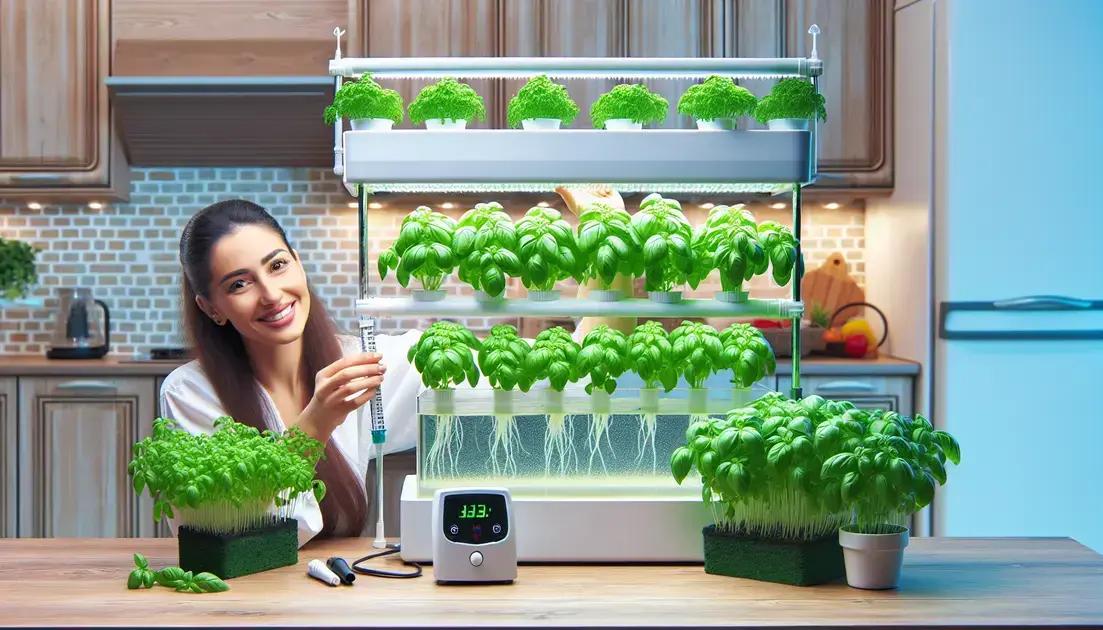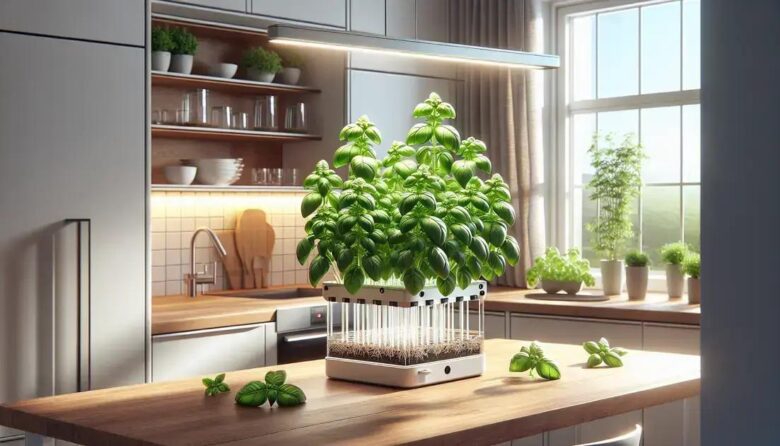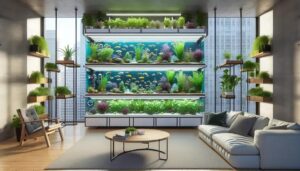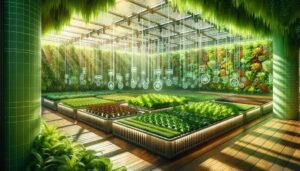Basil hydroponic apartment kitchen systems are perfect for anyone short on outdoor space but keen on fresh herbs. Imagine plucking vibrant green leaves right beside your stove. Whether you’re an urban dweller or just looking for a home project, this guide will walk you through the steps for successful indoor gardening with hydroponics.
Setting up your hydroponic system
Setting up your hydroponic system in an apartment kitchen may sound daunting, but with the right approach, it’s quite manageable. Start by deciding on a spot that receives ample natural light, like near a window. If natural light is insufficient, consider investing in a grow light to ensure your basil plants receive the necessary energy to flourish.
Essential Components
Your hydroponic system will need a few basic components: a nutrient reservoir, a water pump to circulate nutrients, and a medium to hold your plants. Many beginners use small, ready-made kits that contain everything you need, simplifying the setup process.
Nutrient Solution
Using the right nutrient solution is key to your success. These solutions can often be purchased pre-mixed, ensuring your basil gets all the vital minerals. Regularly check and adjust the pH levels to keep the nutrients in a range optimal for basil growth, typically around 6.0 to 7.0.
Plant Spaces
Position your basil plants so they have enough space to grow without being crowded. This will help to prevent disease and ensure they receive adequate light and air circulation. Consider a tray or container that fits well within your kitchen space.
By following these steps, you can enjoy fresh, home-grown basil all year round, turning your apartment kitchen into a personal green oasis.
Choosing the right basil variety

When choosing the right basil variety for your hydroponic system, it’s important to consider the space you have and your taste preferences. There are several types of basil you can grow indoors, but not all varieties will fit well in a limited kitchen space.
Popular Basil Varieties
Genovese basil is a classic choice, known for its large, aromatic leaves perfect for making pesto. If you have more limited space, consider Dwarf Greek basil, which has smaller leaves and a more compact size, making it ideal for small containers.
Specialty Basil Varieties
Experimenting with specialty varieties can add unique flavors to your dishes. Lemon basil offers a citrusy zing, while Thai basil boasts a hint of anise, ideal for Asian recipes. Make sure to select a variety that complements the kinds of meals you enjoy cooking the most.
Consider availability and growth conditions before making your choice to ensure a thriving crop of basil that suits both your needs and your kitchen space.
Creating ideal growing conditions
To ensure your basil thrives, creating ideal growing conditions in your hydroponic setup is essential. Start with lighting, a crucial factor. Basil requires about 12 to 16 hours of light per day. If sunlight is limited in your apartment, use a full-spectrum grow light to simulate sunlight and keep your plants healthy.
Humidity and Temperature
Maintaining the right humidity and temperature is also important. Basil prefers temperatures between 70°F to 80°F during the day. To keep the humidity balanced, place a small humidifier near your setup, especially if the air tends to dry out.
Air Circulation
Good air circulation prevents mold and pests. A small fan can gently circulate air around your plants, keeping them strong and lessening the chances of disease.
Ensure your nutrient solution stays optimal by monitoring the pH and nutrient levels regularly. A balanced environment will help your basil plants grow lush and full of flavor.
Maintaining a hydroponic system

Consistent care is crucial for maintaining a hydroponic system effectively. Regular maintenance ensures your basil plants grow healthy and vigorous. Start by checking the water and nutrient levels daily. Top off the reservoir with clean water and a nutrient mix when necessary to keep the solution balanced.
System Cleanliness
Keep the system clean to prevent algae and bacteria growth. Clean the tank, pipes, and other components regularly by rinsing them with mild soap and water. Avoid harsh chemicals as they might harm your plants.
Monitoring pH Levels
Use a pH meter to check the pH levels of your nutrient solution at least once a week. Basil thrives in a pH range of 6.0 to 7.0. Adjust the levels with pH up or down solutions to keep within this range.
By following these maintenance tips, your hydroponic system will continue to support lush, aromatic basil and provide fresh herbs for your kitchen year-round.
Harvesting and using your basil
Properly harvesting your basil ensures ongoing growth and abundant leaves. Start by using sharp scissors or pruning shears to cut the stems above a leaf node. This encourages further growth and keeps your basil plant healthy. Aim to harvest in the morning for the best flavor, when the essential oils are most concentrated.
Using Fresh Basil
Once harvested, fresh basil can enhance many dishes. Tear the leaves to release more flavor, perfect for topping pizzas and salads. You can also blend them into a vibrant pesto or stir into sauces for a burst of fresh taste.
Preserving Basil
For longer storage, consider drying or freezing your basil. Hang small bunches upside down in a warm, dry place or use a dehydrator. For freezing, chop leaves and place them in ice cube trays with a bit of water or olive oil.
By harvesting strategically, you maintain plant health and ensure a constant supply of flavorful basil for your culinary creations.
Troubleshooting common issues

Troubleshooting common issues in hydroponic gardening can ensure your basil plants stay healthy and productive. One frequent problem is nutrient deficiency, often signaled by yellowing leaves or stunted growth. Check your nutrient solution balance and pH levels, adjusting them as needed to provide essential minerals.
Pests and Diseases
Pests such as aphids or fungus gnats can affect indoor plants. Introduce natural predators like ladybugs or use insecticidal soap. For diseases, ensure good air circulation and remove any affected plants to prevent spread.
Algae Growth
Algae can form in the water if exposed to too much light. Cover your water reservoir and use opaque containers to block light and prevent algae growth.
By addressing these issues promptly, you maintain a healthy growing environment and enjoy a continuous supply of fresh basil.
The Benefits of Hydroponic Basil Growing
Growing basil hydroponically in your apartment kitchen offers fresh herbs year-round without the need for outdoor space. By setting up a basic system, choosing the right variety of basil, and maintaining ideal conditions, you ensure a healthy yield.
Regular maintenance and being aware of common issues keep your plants thriving. From harvesting fresh basil leaves to troubleshooting problems, each step contributes to a successful indoor garden.
Try this compact gardening method to enjoy vibrant, flavorful basil in your home cooking while experiencing the joy and convenience of home-grown produce.
FAQ – Frequently Asked Questions About Growing Basil Hydroponically at Home
What is the first step to starting a hydroponic basil setup?
Begin by choosing a location with sufficient light or set up a grow light, and gather basic hydroponic equipment like a nutrient reservoir and water pump.
How do I choose the right basil variety for hydroponics?
Consider your space and flavor preference. Genovese basil is popular, while Dwarf Greek basil suits smaller spaces.
What are the ideal conditions for growing hydroponic basil?
Ensure 12-16 hours of light per day, with 70°F to 80°F temperature and balanced humidity using a small fan and humidifier.
How should I maintain my hydroponic system?
Check nutrient and water levels daily, clean the setup regularly, and monitor pH to keep it between 6.0 and 7.0.
How can I use fresh basil in my cooking?
Use fresh basil in pestos, as a salad topping, or to add flavor to sauces and dishes. Harvest in the morning for best taste.
How do I troubleshoot common hydroponic issues?
Address nutrient deficiencies by adjusting solutions, use natural methods for pest control, and cover reservoirs to prevent algae.



